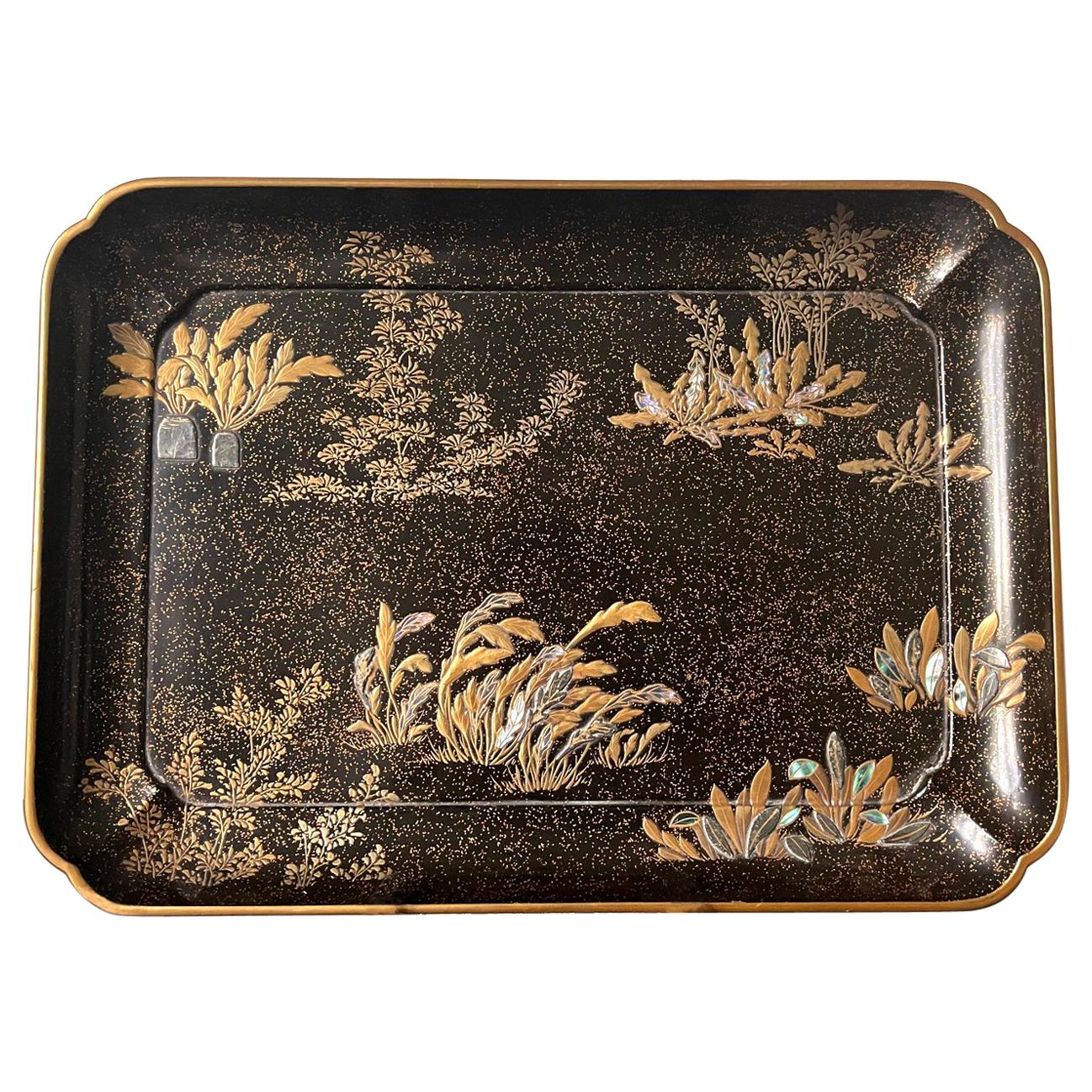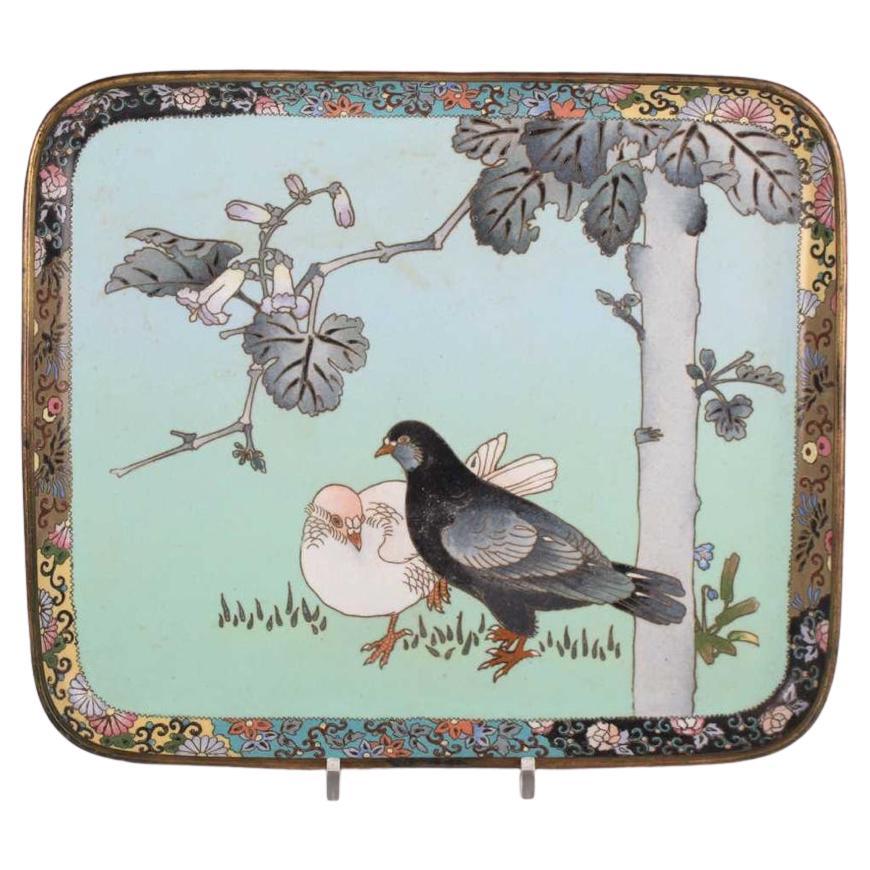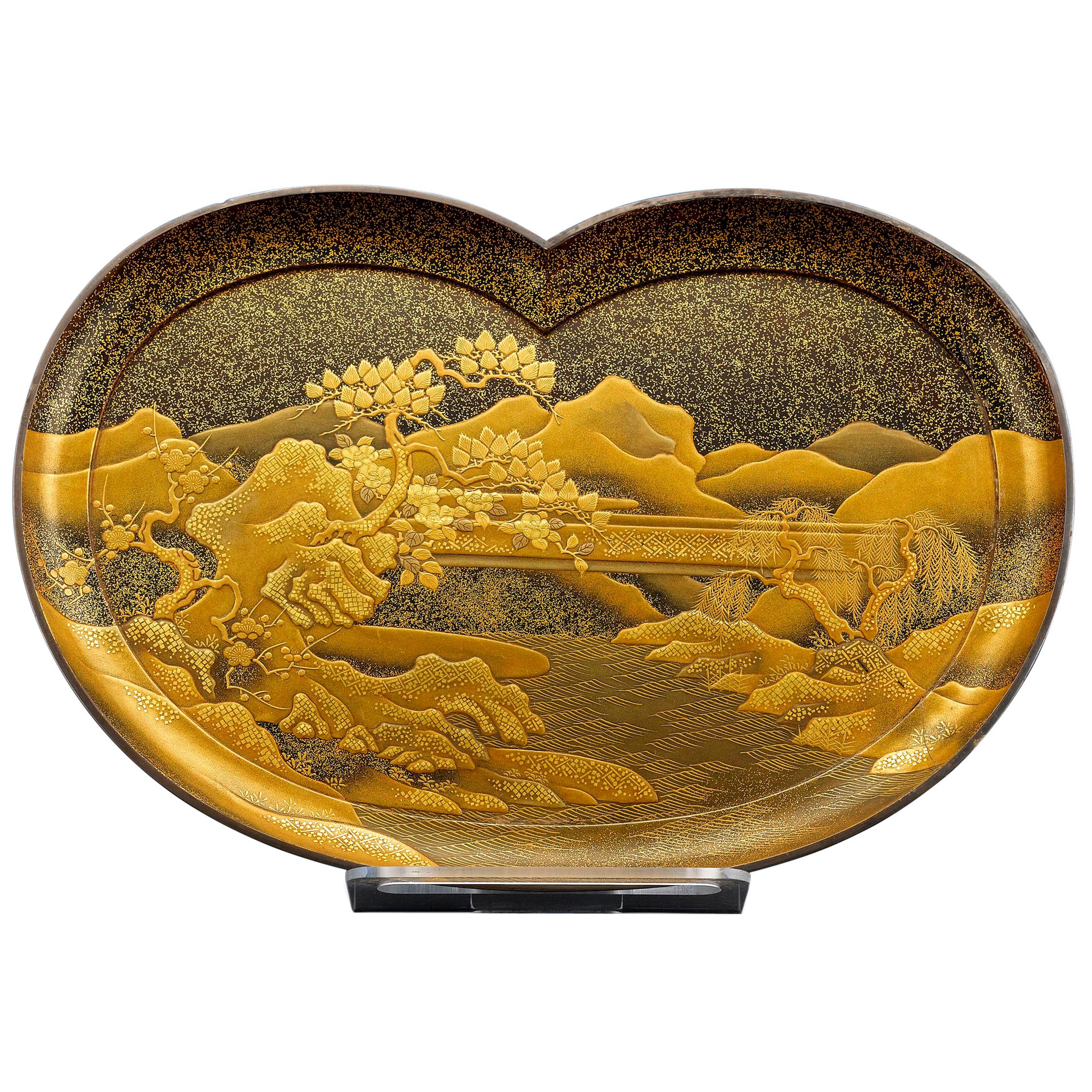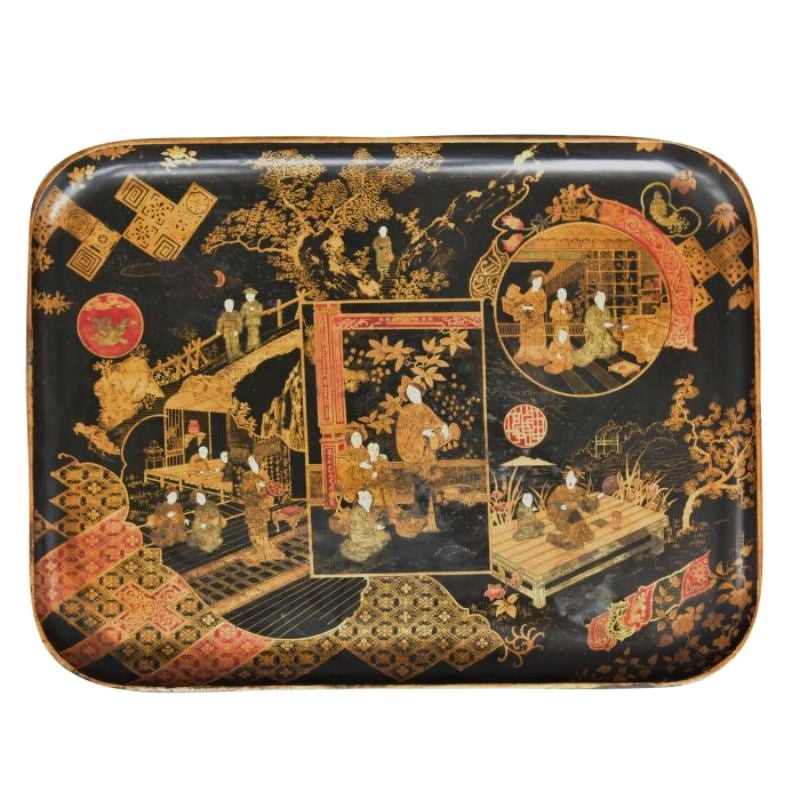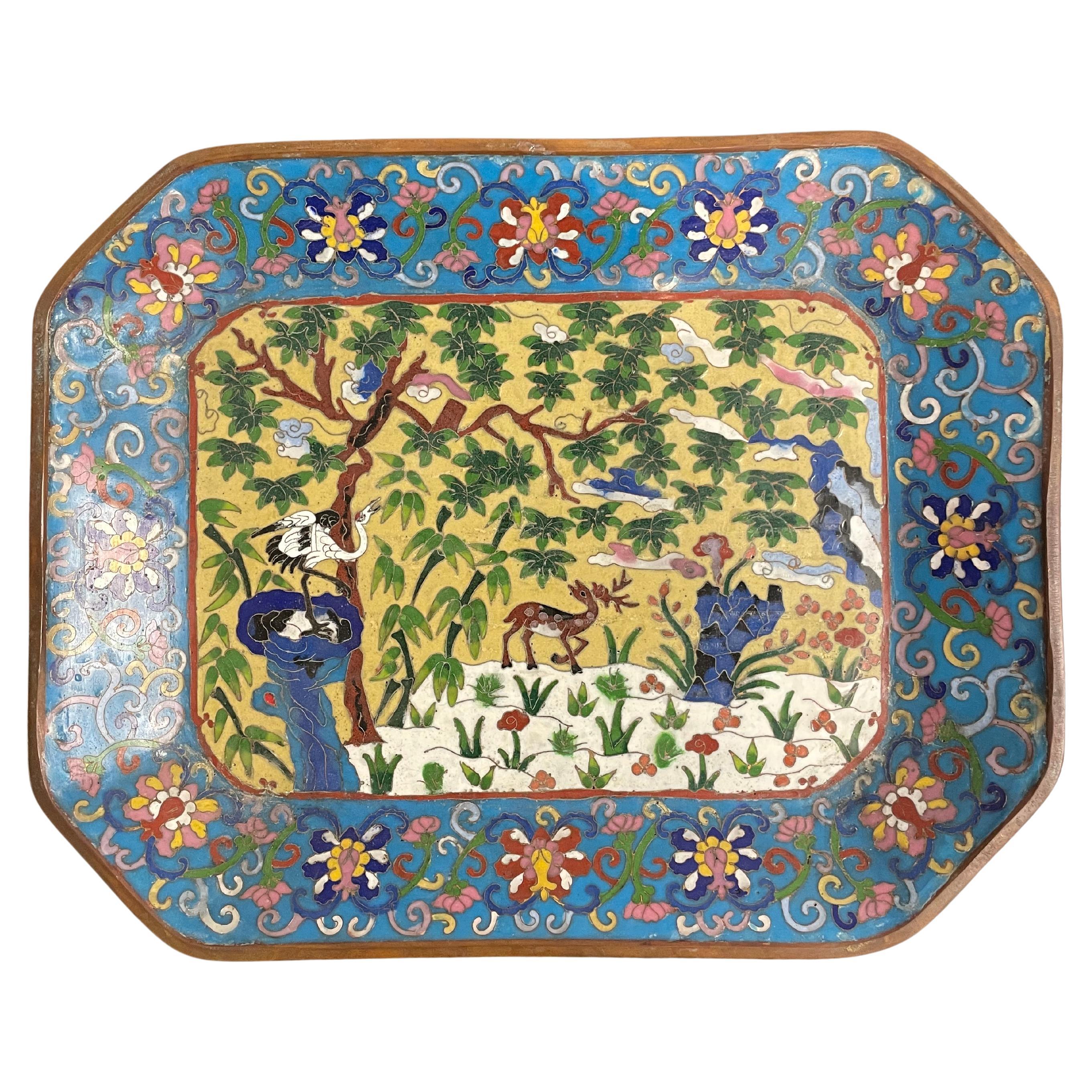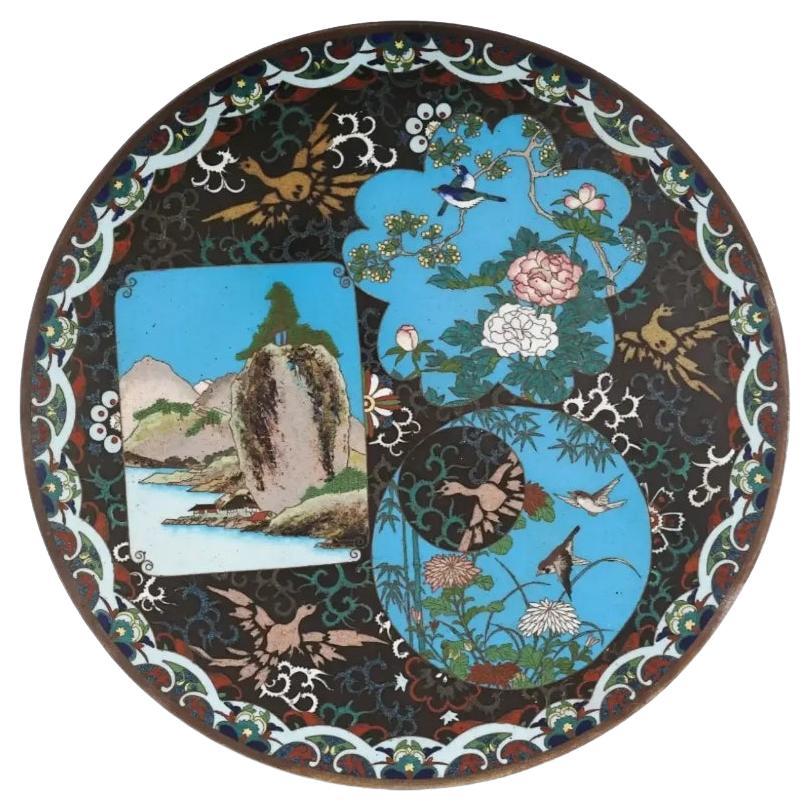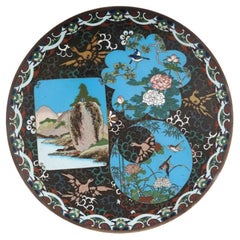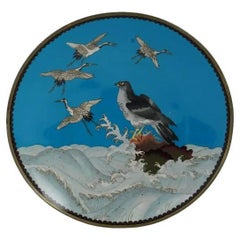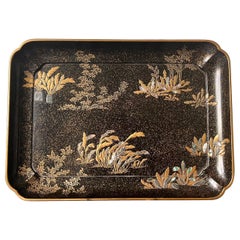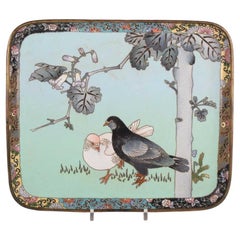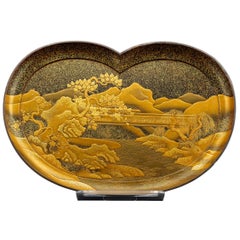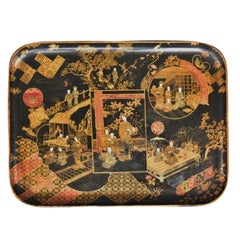Items Similar to Japanese Wireless Cloisonné Serving Tray Meiji After Namikawa Sosuke
Want more images or videos?
Request additional images or videos from the seller
1 of 6
Japanese Wireless Cloisonné Serving Tray Meiji After Namikawa Sosuke
$12,000
£9,111.88
€10,420.12
CA$16,765.74
A$18,647.16
CHF 9,736.97
MX$226,916.14
NOK 124,355.95
SEK 116,623.94
DKK 77,769.35
Shipping
Retrieving quote...The 1stDibs Promise:
Authenticity Guarantee,
Money-Back Guarantee,
24-Hour Cancellation
About the Item
A rare 19th Century Japanese copper serving tray with cloisonne enamel design. The central part of the tray depicts a wireless cloisonne picture, a coastal landscape view with a full moon. The hieroglyphical signature of the artist is in the lower right. The rims and the backside are decorated with floral ornaments. Blue and black color palette. Collectible Oriental Decor And Applied Arts For Interior Design.
Namikawa Sosuke (1847–1910) was a Japanese cloisonné artist,[1] known for innovations that developed cloisonné enamel into an artistic medium sharing many features with paintings.[2][3] He and Namikawa Yasuyuki (no relation)[notes 1] were the most famous cloisonné artists of the 1890 to 1910 period, known as the "golden age" of Japanese enamels.[1] Around 1880 he set up and ran the Tokyo branch of the Nagoya Cloisonné Company.[1] He exhibited his artworks at national and international expositions, where he took an organising role.[2] He was recognised as an Imperial Household Artist and created art works for imperial residences. He sometimes signed his works with the character sakigake (Pioneer)
the art work is based off a art work done by Sesshu Toyo
Sesshu Toyo (?? ??, c. 1420 – August 26, 1506), also known simply as Sesshu (??), was a Japanese Zen monk and painter who is considered a great master of Japanese ink painting. Initially inspired by Chinese landscapes, Sesshu's work holds a distinctively Japanese style that reflects Zen Buddhist aesthetics.[1] His prominent work captured images of landscapes, portraits, and birds and flowers paintings, infused with Zen Buddhist beliefs, flattened perspective, and emphatic lines.[2]
Sesshu was born into the samurai Oda family (???) and trained at Shokoku-ji temple in Kyoto, Japan, as a Zen monk.[1] From his early childhood, Sesshu showed a talent for painting and eventually became widely revered throughout Japan as a wise, reputable Zen scholar, and the greatest painter priest of Zen-Shu.[3]
Sesshu worked in a painting atelier whilst training under Tensho Shubun (c. 1418–1463). But upon visiting China, his work betook a distinctive Chinese influence, merging Japanese and Chinese styles to develop his individualistic style of Zen paintings.[3] Sesshu's influence on painting was so wide that many schools of art appointed him their founder.[4] Sesshu's most acclaimed works are Winter Landscape (c. 1470s), Birds and Flowers (1420–1506) and Four Landscape Scrolls of the Seasons (1420–1506).
Dimensions: 10 3/4 x 7 in. All measurements are approximate.
Condition
Good antique condition. Signs of age and wear. Refer to photos.
- Dimensions:Height: 10.75 in (27.31 cm)Diameter: 7 in (17.78 cm)
- Materials and Techniques:
- Place of Origin:
- Period:
- Date of Manufacture:1890
- Condition:Wear consistent with age and use.
- Seller Location:Long Island City, NY
- Reference Number:1stDibs: LU7386233347622
About the Seller
4.9
Platinum Seller
Premium sellers with a 4.7+ rating and 24-hour response times
1stDibs seller since 2022
95 sales on 1stDibs
Typical response time: <1 hour
- ShippingRetrieving quote...Shipping from: Long Island City, NY
- Return Policy
Authenticity Guarantee
In the unlikely event there’s an issue with an item’s authenticity, contact us within 1 year for a full refund. DetailsMoney-Back Guarantee
If your item is not as described, is damaged in transit, or does not arrive, contact us within 7 days for a full refund. Details24-Hour Cancellation
You have a 24-hour grace period in which to reconsider your purchase, with no questions asked.Vetted Professional Sellers
Our world-class sellers must adhere to strict standards for service and quality, maintaining the integrity of our listings.Price-Match Guarantee
If you find that a seller listed the same item for a lower price elsewhere, we’ll match it.Trusted Global Delivery
Our best-in-class carrier network provides specialized shipping options worldwide, including custom delivery.More From This Seller
View AllJapanese Meiji Era Cloisonne Enamel Plate Charger
Located in Long Island City, NY
An antique Japanese, Meiji era, enamel over brass charger or plate. The plate is adorned with polychrome medallions depicting birds in chrysanthemum flowers, and a river mountain lan...
Category
Antique Mid-19th Century Japanese Meiji Tableware
Materials
Brass, Enamel
Exquisite Antique Meiji Japanese Cloisonne Tray Featuring Dragons in Clouds, Att
Located in Long Island City, NY
An antique Japanese, late Meiji era, enamel over copper tray. The interior of the ware is adorned with a polychrome enamel design representing figural medallions depicting plants in ...
Category
Antique Late 19th Century Japanese Meiji Metalwork
Materials
Enamel, Copper
Large Japanese Meiji Era Cloisonne Enamel Charger
Located in Long Island City, NY
A large antique Japanese, Meiji era, enamel over brass charger or plate. The plate is adorned with polychrome figural medallions depicting landscape and pond views, birds in sakura t...
Category
Antique Mid-19th Century Japanese Meiji Tableware
Materials
Brass, Enamel
Antique Japanese Meiji Era Cloisonne Enamel Plate
Located in Long Island City, NY
An antique Japanese Meiji era enamel over copper charger plate. The exterior of the plate is adorned with a polychrome scene with an eagle standing on a rock and cranes flying over w...
Category
Antique Late 19th Century Japanese Meiji Metalwork
Materials
Copper, Enamel
$1,250 Sale Price
50% Off
Antique Japanese Meiji Era Cloisonne Enamel Plate Goto
Located in Long Island City, NY
An antique Japanese, probably Goto school, enamel over copper charger plate.
The exterior of the plate is adorned with a polychrome image of ducks flying over a pond with blossomin...
Category
Antique Late 19th Century Japanese Metalwork
Materials
Copper, Enamel
Antique Early Meiji Japanese Cloisonne Phoenix Bird Tray
Located in Long Island City, NY
An antique Japanese, Early Edo period, enamel copper tray. The oval shaped tray is enameled with a polychrome image of a Phoenix bird with flowers and leaves made in the Cloisonne te...
Category
Antique Late 19th Century Japanese Meiji Metalwork
Materials
Enamel, Copper
$2,000 Sale Price
50% Off
You May Also Like
Japanese Lacquer Tray with Maki-e and Inlay Hara Yoyusai Edo Period
Located in Atlanta, GA
A lovely Japanese lacquer rectangular lacquer tray with a slightly scalloped corner and four L shape supporting feet by one of the most celebrated lacquer artist active in Edo period Hara Yoyusai (1772-1845). Yoyusai lived in Edo (Tokyo) and worked under the patronage of Lord Matsudaira. He operated a large workshop and had a very prolific output of lacquer objects. Most survived pieces being inro...
Category
Antique 19th Century Japanese Japonisme Lacquer
Materials
Wood, Lacquer
A Fine Japanese Meiji Period Cloisonné Enamel Tray Attributed to Namikawa Sösuke
Located in London, GB
A Japanese Meiji Period Cloisonné Enamel
Tray Attributed to Namikawa Sösuke, Late 19th Century
A refined rectangular cloisonné enamel tray with softly rounded corners and shallow...
Category
Antique 19th Century Japanese Metalwork
Materials
Enamel
Japanese Lacquer Tray
Located in New Orleans, LA
As beautiful as it is practical, this Japanese Meiji-period lacquered tray is distinguished by its exceptional craftsmanship. It exhibits a phenomenal artistry as the entire tray is ...
Category
Early 20th Century Japanese Meiji Lacquer
Materials
Lacquer
$8,850
Asian Lacquer Tray
Located in Marseille, FR
Tray in black lacquer and gold paint with scenes of life in Japan at the end of the 19th century. Size 47 cm by 62 cm.
Additional information:
Material: Lacquer.
Category
Antique 19th Century Platters and Serveware
Materials
Lacquer
$1,198
A Chinese Cloisonne Tray with Qianlong Mark, Early 20th Century
Located in ARMADALE, VIC
A Chinese Cloisonne Tray with Qianlong Mark, Early 20th Century
Home decor, Interior design and collectibles.
Provenance: Private Victoria Collection.
...
Category
Early 20th Century Chinese Metalwork
Materials
Bronze
$460 Sale Price
50% Off
Large Vintage Japanese Maki-e Lacquer Kimono Tray
Located in Atlanta, GA
A large square lacquer presentation tray (likely for kimono) predated 1950 of the Showa period. Elaborately decorated with Maki-e that depicts the prunus blossom, bamboo and needle p...
Category
Vintage 1940s Japanese Japonisme Lacquer
Materials
Wood, Lacquer
More Ways To Browse
Japanese Enamel
Cloisonne Copper
Japanese Samurai Art
Japanese Zen Furniture
Japanese Monk
Bird Tray
Japanese Scroll Flower
Cloisonne Set
Antique Copper Ornaments
Antique Copper Trays
Japan Cloisonne Birds
Temple Japanese Buddhist
Antique Furniture Tokyo
Rare Cloisonne
Buddhist Flowers
The Four Seasons 19th Century
Blue Bird Furniture Company
Temple Ornament
